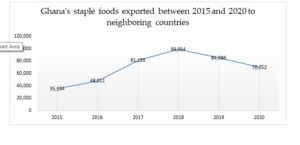…Transform food production from potentials to reality through investments and policy options
Agriculture is a major driver of Ghana’s economic growth. Its contribution to the country’s GDP is around 19 percent, not counting indirect contributions through links with manufacturing, and service industries.
Agriculture is profoundly important to nearly every one of Ghana’s population. Over 30 percent depend on the sector for their livelihood and survival, and around 80 percent of rural incomes come from agriculture.
However, Ghana’s agricultural sector still performs averagely, and its enormous potentials remain untapped. The country still lags behind other countries in terms of productivity, agricultural mechanization, advisory and extension services, and access to credit and financial markets.
For instance, countries like Brazil, Israel, and the Netherlands are able to generate over 100 billion United States dollars annually from agriculture due to the high investments and policy options they have made over the years.
Today, agriculture in Israel is a highly developed industry despite the fact that the geography of the country is not naturally conducive to agriculture. More than half of the land area is desert, and the climate and lack of water resources do not favor farming yet they are food self-sufficient and a major exporter of fresh produce, and a world – leader in agricultural technologies.
Despite our endowments with abundant land, and water resources, we are unable to produce enough food to feed our people all year round. As a result, Ghana is a net food importer from fresh produce (tomatoes, onion, etc.) to grains (maize, rice, etc.) to poultry, cooking oil, sugar, and fish.
The resulting food import bill of $ 2.4 billion in 2019 is expected to double by 2030 if immediate mitigation measures are not implemented. In view of the foregoing, a more radical approach is needed if Ghana wants to achieve agricultural transformation, solve the challenge of unemployment, reduce poverty drastically, and generate high annual revenues to build the country.
In this article, I share with some statistics put forward by the minister of Food and Agriculture Dr. Owusu Afriyie in his recent minister’s media briefing that took place on the 28th August 2021. I will analyze the data and indicate the prospects the country can tap into, and lastly, propose some policy options and recommendations for turning agricultural potentials to reality in Ghana.
The food and agriculture minister said that Ghana exported 70,052 metric tonnes of staple foods to neighboring countries in 2020. The data made public by the minister revealed that Ghana exported 418,450 metric tonnes of staple foods to neighboring countries spanning 2015 – 2020.
The minister also expressed that annual export of the five staple foods namely: maize, rice, yam, plantain, and soybean in the past six years is 35, 154 metric tonnes in 2015, 48, 011 metric tonnes in 2016, 81,193 metric tonnes in 2017, 99,054 metric tonnes in 2018, and 84,986 metric tonnes in 2019.
In addition, the minister revealed that the annual export of maize in the past six years is 11,015 metric tonnes, 10,909 metric tonnes, 19,666 metric tonnes, 23,483 metric tonnes, 14,128 metric tonnes, and 17,240 metric tonnes for the period covering 2015 – 2020 respectively.
The figures for rice are 3,400 metric tonnes, 3,066 metric tonnes, 3,671 metric tonnes, 3,527 metric tonnes, 759 metric tonnes, and 322 metric tonnes for the years covering 2015 – 2020 respectively. Data made public also indicate that Ghana exported yam of 2,489 metric tonnes in 2015, 10,503 metric tonnes in 2016, 13,352 metric tonnes in 2017, 24,667 metric tonnes in 2018, 29,078 metric tonnes in 2019, and 31,127 metric tonnes in 2020.
Again, Dr. Owusu Afriyie said that the annual export of plantain in the past six years is 16,052 metric tonnes, 21,459 metric tonnes, 40,935 metric tonnes, 43,802 metric tonnes, 40,190 metric tonnes, and 20,667 metric tonnes for the period covering 2015 – 2020 respectively.
Lastly, he indicated that the annual export of soybean to neighboring countries in the past six years is 2,198 metric tonnes, 2,073 metric tonnes, 3,569 metric tonnes, 3,575 metric tonnes, 830 metric tonnes, and 697 metric tonnes for the years covering 2015 – 2020 respectively.
Below is the graphical presentation of the staple foods namely maize, rice, yam, plantain, and soybean exported to the neighboring countries between 2015 and 2020. Here, I present the data in a graphical way.

Maize is a widely consumed and cultivated staple crop in Ghana. The ministry of food and agriculture (MOFA) indicated in 2020 that the average maize output over the period 2017 to 2019 was 40 percent higher than the average output achieved between 2013 and 2016.
However, the demand for maize has gone beyond supply in recent times. The shortage of maize has persisted for close to a year, and prices have doubled in just within a year. The government recently issued permits for the import of 60,000 metric tonnes of yellow maize to support poultry farmers in their feed production.
The high price of maize today shows that we are not in a position where we should be exporting maize to neighboring countries. To tap into the export markets, MOFA should consider how we can double our maize production capacity so as to have enough excess for the neighboring countries.
Rice is an important staple food in Ghana and is cultivated across all the agroecological zones. In 2008 and 2018, paddy rice grew at 10 percent per year, and a very sharp increase of 25 percent in 2019.
However, domestic production continues to fall short of demand with the import share of rice consumed remaining above 60 percent. Ghana currently spends over a billion-dollar to import rice every year.
With the aim of attaining self-sufficiency in rice and promoting pro-poor, sustainable development in the rice value chain, different policy options have to be identified, and this needs to be backed with huge investment.
Ghana is the world’s second-largest yam producer after Nigeria. With close to ten million tonnes of yam produced every year, the country was able to export 31,127 metric tonnes in 2020. Available statistics indicate between 40 percent of yam harvested in Ghana are lost through post-harvest storage.
The income levels of farmers, processors, traders, and other stakeholders are affected yearly as a result. The figures given by the sector minister indicate that with the right investment and an effective roadmap of the crop’s value chain, we can harness the exceptional qualities of the crop which are yet to be fully exploited for economic growth and food security.
Ghana is a major plantain producer in Africa, and untapped potential lies in the use of plantain residues. A published study has indicated that Ghana has got the infrastructure and institutional structures that would allow for developing a sustainable commercial use of plantain residues for fiber.
Ghana has a huge potential to produce and process soybeans for local consumption and export. There is high demand for soybeans internationally, the current production level cannot meet the expectation. There is also a demand for soybeans to feed local companies producing fish and poultry feed, and our inability to meet the demand has led to the importation of the crop which is also contributing to Ghana’s import dependency.
From the above discussion, it can be seen that the potential for the export markets is very huge. Ghana’s staple foods are consumed in the whole of Africa and beyond, and so setting the right policy measures, and being intentional about the development of staple foods in Ghana can aid our economic growth, create sustainable jobs, and ensure food security.
The transformation of Ghana’s food and agriculture is critical to averting foreseeable food challenges. Ghana’s rapid population growth, and urbanization, coupled with the high unemployment rate means that we must grow to feed the rising population, ensure food security, and create sustainable jobs through agribusiness. To achieve this aim, the agriculture sector needs to be transformed.
Agricultural value chains must be modernized, agribusiness promoted, agricultural mechanization widespread among farmers, credit constraints removed, and the agricultural infrastructure gap closed. It is under such circumstances that the transformation of Ghana’s food and agriculture sector will be successful and become a driving force for economic growth.
Government should create a regulatory framework to overcome the challenge of shortage of crops like maize, and soybeans. The framework could contribute to coordinating public and private investments into the sub-sector, and ensure that the country’s supply is always above its demand.
There is the need to consider developing national value chains with production hubs for the staple foods in Ghana. This is to help create jobs and add value to the raw production of our staple foods. Expand the introduction of modern agricultural practices and training, and begin implementing affirmative policies to ensure that agriculture and agribusiness become a priority to the youth of Ghana.
A recent study has stated that despite the African Continental Free Trade Area (AfCFTA) agreement offering Ghanaian businesses the opportunity to trade in a market worth $3.4 trillion, only 25% of agribusinesses are aware of the opportunity. The future of AfCFTA is local and calls for more investment for the opportunities to be fully leveraged.
Mr. Strive Masiyiwa, the billionaire and investor recently stated that, if we are to lift the prosperity of our people, we must encourage entrepreneurship in agriculture, along the entire food chain, supply chain, production systems, market systems, products using agricultural produce.
It must be a transformative agenda that looks beyond producing more maize, rice, cassava, and other staples, but rather thinks about innovations using these very same staples. This is an indication that Africa’s agricultural sector still performs poorly, and its enormous potential remains untapped.
The writer is a food security analyst, venture builder, and agribusiness consultant. He is very passionate about food insecurity mitigation in Africa, and believes that ending hunger is too small a vision for Africa. He holds a doctorate degree in Agricultural Economics & Management. He can be reached on [email protected]










